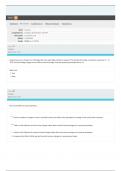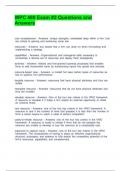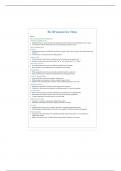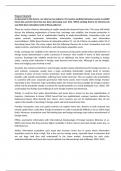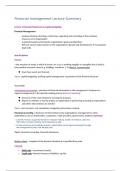Social psychology:
Chapter two: Social Cognition, how we think about the social world:
Schemas: Mental Frameworks for Organising and Using Social Info:
Schema: metal frameworks that allow us to organise large amount of information in an efficient manner, once formed they have
strong effects on social thought, which are not always accurate.
Experience has helped ppl build up mental frameworks that help organize knowledge/ assumptions about particular subjects. (Like
ppl, places, and situations).
Social psychologist call these frameworks schemas and define them as mental structures that help us organize social info and
guide processing of this info.
All people in a given society tend to share basic schemas.
Impact of schemas on social cognition: attention, encoding, retrieval.
Schemas influence social thought in 3 processes:
Attention: what info we notice. With attention: schemas act as a filter, it stores info that is consistent with our schemas and
discards that which is not, unless it is so extreme we can not help but notice it.
Encoding: process through which info we notice gets stored in the memory. With encoding: which is specific info that goes into our
memory, info that becomes focus of our attention is much more likely to enter long term memory. So again it is info consistent with
our schemas that is encoded. Unless it is unique.
Retrieval: process by which we recover info from memory 2 use in some way. What info is remembered easiest? Inconsistent with
our schemas mainly b/c it is used more often. Info that is inconsistent might be present as strongly sometimes, but ppl tend to report
that which is consistent with their schemas. No answer to Q.
Priming: which schemas guide our thoughts?
Which schemas guide our thoughts and when:
Stronger and better developed ones are more likely to influence our thinking and especially our memory for social info.
Schemas can be temporarily activated by
Priming- transitory increase in the ease with which specific schemas can be activated
Produced by experiences relevant to schemas.
Recent experiences make some schemas more active (Eg, seeing violent movie schemas for violence activated)
Recent experience exerts stronger effects on current thinking.
How powerful is priming??? According to study very and may last long… (Eg. In study ppl who saw pics 17 yrs ago recognized
more easily 2day)
Can be deactivated by unpriming thoughts or actions are primed by a recent experience and only persists one it finds expression, it
then disappears. Once primed schemas are somehow expressed then unpriming occurs, priming does not last forever (Eg.
Experiment on ppl to answer Qs correctly)
Schema persistence: why even discredited schemas can sometimes influence our thoughts and behaviours:
Even though they are NB they have a downside schemas influence what we notice, enter into our memory and what we remember
and therefore distort out understanding of the social world. (Eg. Stereotyping)
Once they are formed they are often resistant to change they show a strong perseverance effect remaining unchanged even in the
face of opposite info. (accountant who is fun, don’t change schemas rather say he is exception)
Schemas can be self fulfilling and influence our responses. (Eg. Teacher who acted better 2 “promising kids” made them better)
Heuristics: How We Reduce Our Effort In Social Cognition:
Heuristics: simple rules of thumb we often use in order to make decisions or draw inferences quickly and with minimal effort
At any given time we can only cope with a specific amount of info otherwise we get info overload.
This can be enhanced by stress or other demands on us.
, This is a reason why so much of our social thought is automatic.
There are a number of diff ways heuristics can happen, they are explained bellow
The “Building the Science” section
Schemas do often shape behaviour in ways that lead to their conformation:
- Teachers’ lower expectations for success by minority students undermined the confidence of these students and actually contributed
to poorer success.
- Self-confirming effects of schemas do not result from deliberate attempts by people to confirm these mental frameworks. On the
contrary, they occur even when individuals attempt to avoid letting their expectations shape their behaviour towards others.
Thus schemas are definitely a two-edged sword:
They help us to make sense out of the social world and to process vast amounts of information quickly and with
minimal effort.
They can also lock us into perceiving the world in ways that may not, in fact, be accurate.
Representitivness- judging by resemblance:
Representativeness heuristic
A strategy for making judgments based on the extent to which current stimuli or events resemble other stimuli or categories (e.g. the
more similar an individual is to typical members of a given group, the more likely she/he is to belong to that group.
Are such judgments accurate?
Often they are right, because belonging to certain groups does affect the behaviour and style of people in them and
because people with certain traits are attracted to particular groups in the first place.
Sometimes, these judgments are wrong mainly because decisions or judgments made on the basis of this rule tend
to ignore base rates - the frequency with which events or patterns occur in the total population.
Because of our strong tendency to use the representativeness heuristic, we tend to ignore such base rate information and base our
judgments on similarity to typical members of a group or category. In this and related ways, the representativeness heuristic can lead
to errors in our thinking about others.
Availability: “if I can think of it, it must be NB”
We assume that because we can easily recall a certain scene, it actually reflects the overall situation when, in fact, it doesn’t.
Availability heuristic
Easier it is 2 bring info 2 mind the greater the impact on the decisions we make
This heuristic makes good sense:
The fact that we can bring some information to mind quite easily suggests that it must be frequent or important and
should influence our judgments and decisions.
It can also lead to errors:
It can lead us to overestimate the likelihood of events that are dramatic but rare because they are easy to bring to
mind (e.g. people fear travel in airplanes more that travel in automobiles, even though the chances of dying in an
auto accident are hundreds of times higher).
Two factors in availability heuristic:
1. The subjective ease with which relevant information comes to mind.
2. The amount of information we can bring to mind (the more information, the greater impact on judgment).
Which of these two is more important?
It depends on the kind of judgment we are making.
If it involves emotions or feelings - the “ease” rule.
If it involves facts or information - the “amount” rule.
Anchoring and adjustment: where you begin makes a difference:
Anchoring and adjustment heuristic
Involves the tendency to deal with uncertainty in many situations by using something we do know as a starting point and then making
adjustments to it.
Existence of the anchoring and adjustment heuristic is far from surprising: In uncertain situations we have to start somewhere.
What is surprising, however, is how powerful this effect is even in situations where, rationally, it should not operate.
Chapter two: Social Cognition, how we think about the social world:
Schemas: Mental Frameworks for Organising and Using Social Info:
Schema: metal frameworks that allow us to organise large amount of information in an efficient manner, once formed they have
strong effects on social thought, which are not always accurate.
Experience has helped ppl build up mental frameworks that help organize knowledge/ assumptions about particular subjects. (Like
ppl, places, and situations).
Social psychologist call these frameworks schemas and define them as mental structures that help us organize social info and
guide processing of this info.
All people in a given society tend to share basic schemas.
Impact of schemas on social cognition: attention, encoding, retrieval.
Schemas influence social thought in 3 processes:
Attention: what info we notice. With attention: schemas act as a filter, it stores info that is consistent with our schemas and
discards that which is not, unless it is so extreme we can not help but notice it.
Encoding: process through which info we notice gets stored in the memory. With encoding: which is specific info that goes into our
memory, info that becomes focus of our attention is much more likely to enter long term memory. So again it is info consistent with
our schemas that is encoded. Unless it is unique.
Retrieval: process by which we recover info from memory 2 use in some way. What info is remembered easiest? Inconsistent with
our schemas mainly b/c it is used more often. Info that is inconsistent might be present as strongly sometimes, but ppl tend to report
that which is consistent with their schemas. No answer to Q.
Priming: which schemas guide our thoughts?
Which schemas guide our thoughts and when:
Stronger and better developed ones are more likely to influence our thinking and especially our memory for social info.
Schemas can be temporarily activated by
Priming- transitory increase in the ease with which specific schemas can be activated
Produced by experiences relevant to schemas.
Recent experiences make some schemas more active (Eg, seeing violent movie schemas for violence activated)
Recent experience exerts stronger effects on current thinking.
How powerful is priming??? According to study very and may last long… (Eg. In study ppl who saw pics 17 yrs ago recognized
more easily 2day)
Can be deactivated by unpriming thoughts or actions are primed by a recent experience and only persists one it finds expression, it
then disappears. Once primed schemas are somehow expressed then unpriming occurs, priming does not last forever (Eg.
Experiment on ppl to answer Qs correctly)
Schema persistence: why even discredited schemas can sometimes influence our thoughts and behaviours:
Even though they are NB they have a downside schemas influence what we notice, enter into our memory and what we remember
and therefore distort out understanding of the social world. (Eg. Stereotyping)
Once they are formed they are often resistant to change they show a strong perseverance effect remaining unchanged even in the
face of opposite info. (accountant who is fun, don’t change schemas rather say he is exception)
Schemas can be self fulfilling and influence our responses. (Eg. Teacher who acted better 2 “promising kids” made them better)
Heuristics: How We Reduce Our Effort In Social Cognition:
Heuristics: simple rules of thumb we often use in order to make decisions or draw inferences quickly and with minimal effort
At any given time we can only cope with a specific amount of info otherwise we get info overload.
This can be enhanced by stress or other demands on us.
, This is a reason why so much of our social thought is automatic.
There are a number of diff ways heuristics can happen, they are explained bellow
The “Building the Science” section
Schemas do often shape behaviour in ways that lead to their conformation:
- Teachers’ lower expectations for success by minority students undermined the confidence of these students and actually contributed
to poorer success.
- Self-confirming effects of schemas do not result from deliberate attempts by people to confirm these mental frameworks. On the
contrary, they occur even when individuals attempt to avoid letting their expectations shape their behaviour towards others.
Thus schemas are definitely a two-edged sword:
They help us to make sense out of the social world and to process vast amounts of information quickly and with
minimal effort.
They can also lock us into perceiving the world in ways that may not, in fact, be accurate.
Representitivness- judging by resemblance:
Representativeness heuristic
A strategy for making judgments based on the extent to which current stimuli or events resemble other stimuli or categories (e.g. the
more similar an individual is to typical members of a given group, the more likely she/he is to belong to that group.
Are such judgments accurate?
Often they are right, because belonging to certain groups does affect the behaviour and style of people in them and
because people with certain traits are attracted to particular groups in the first place.
Sometimes, these judgments are wrong mainly because decisions or judgments made on the basis of this rule tend
to ignore base rates - the frequency with which events or patterns occur in the total population.
Because of our strong tendency to use the representativeness heuristic, we tend to ignore such base rate information and base our
judgments on similarity to typical members of a group or category. In this and related ways, the representativeness heuristic can lead
to errors in our thinking about others.
Availability: “if I can think of it, it must be NB”
We assume that because we can easily recall a certain scene, it actually reflects the overall situation when, in fact, it doesn’t.
Availability heuristic
Easier it is 2 bring info 2 mind the greater the impact on the decisions we make
This heuristic makes good sense:
The fact that we can bring some information to mind quite easily suggests that it must be frequent or important and
should influence our judgments and decisions.
It can also lead to errors:
It can lead us to overestimate the likelihood of events that are dramatic but rare because they are easy to bring to
mind (e.g. people fear travel in airplanes more that travel in automobiles, even though the chances of dying in an
auto accident are hundreds of times higher).
Two factors in availability heuristic:
1. The subjective ease with which relevant information comes to mind.
2. The amount of information we can bring to mind (the more information, the greater impact on judgment).
Which of these two is more important?
It depends on the kind of judgment we are making.
If it involves emotions or feelings - the “ease” rule.
If it involves facts or information - the “amount” rule.
Anchoring and adjustment: where you begin makes a difference:
Anchoring and adjustment heuristic
Involves the tendency to deal with uncertainty in many situations by using something we do know as a starting point and then making
adjustments to it.
Existence of the anchoring and adjustment heuristic is far from surprising: In uncertain situations we have to start somewhere.
What is surprising, however, is how powerful this effect is even in situations where, rationally, it should not operate.


